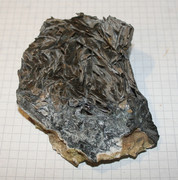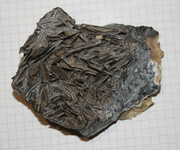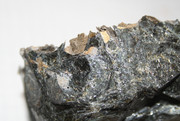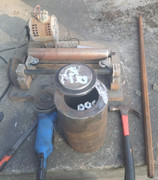Fulmen
International Hazard
    
Posts: 1746
Registered: 24-9-2005
Member Is Offline
Mood: Bored
|
|
Hunting Thorium at Fensfeltet
One of my long standing itches has been Thorium, and after getting a GM detector I've started to scratch that itch a bit. Living not far from Fensfeltet I figured I owed to myself to extract some.
So far I've found two possible sources. The geology is dominated by carbonatites, one of these is the iron bearing rødberg (redrock) with an average Th-content of 872g/ton (maximum 0,4%). This should be freely available (I already have some tailings) but I
will go hunting for hotter samples as well.
But how to process such rock efficiently? I'm dissolving some in HCl right now, but that won't scale well. It's usually made from monazite (phosphate)
so I'm a bit off the beaten track here.
The second option is old niobium slag if it's still accessible, it's reported to be 1,5-2%ThO2 (the bulk material is aluminum oxide). There is even
some ferroniobium left in some of the slag. But availability is unknown for now so I'm exploring both options.
We're not banging rocks together here. We know how to put a man back together.
|
|
|
j_sum1
Administrator
       
Posts: 6371
Registered: 4-10-2014
Location: At home
Member Is Offline
Mood: Most of the ducks are in a row
|
|
Sounds like you need to read The trials and tribulations of thorium production by Dan Vizine. One of the true gems on this board.
A search will bring up several other interesting Thorium threads, full of ideas.
What is the end goal here? Metallic Th? If so, good luck and happy engineering.
|
|
|
Fulmen
International Hazard
    
Posts: 1746
Registered: 24-9-2005
Member Is Offline
Mood: Bored
|
|
I have read a bit in that one already, but he started with thorium nitrate, right? There are other threads as well, but all of them cover monazite
which isn't as relevant for my (I think). But I will keep reading, chances are someone somewhere has done all the legwork for me.
The end goal isn't set in stone yet. Metallic Th would be beyond cool but seems somewhat unrealistic for now. I'll settle for some high Th extract as
my first goal.
Here's a sample of rødberg I picked up this weekend. It's not really that hot, the black rock from the same site was slightly more radioactive. So
I'm gearing up for some spelunking to see if I can get better ore from the mines.
Attachment: phpguhlkL (1MB)
This file has been downloaded 27 times
We're not banging rocks together here. We know how to put a man back together.
|
|
|
Fulmen
International Hazard
    
Posts: 1746
Registered: 24-9-2005
Member Is Offline
Mood: Bored
|
|
Here is a pdf which has several useful maps of the area and the mines in question:
https://www.duo.uio.no/bitstream/handle/10852/109473/ncad178...
We're not banging rocks together here. We know how to put a man back together.
|
|
|
Fulmen
International Hazard
    
Posts: 1746
Registered: 24-9-2005
Member Is Offline
Mood: Bored
|
|
Direct chemical extraction seems to be out of the question. The interesting elements are usually acid soluble, as is the rock so the acid consumption
is going to be huge. At the same time it contains enough non-soluble matter that you can't just dissolve it in acid. So first step will have to be
milling followed by some sort of mechanical separation.
Industrially it seems like flotation is the go-to tech, but that doesn't seem diy-friendly. The rock has a small fraction of magnetic elements (well
duh, it's iron ore), the only other option I can think of is to separate by density.
Any suggestions?
We're not banging rocks together here. We know how to put a man back together.
|
|
|
j_sum1
Administrator
       
Posts: 6371
Registered: 4-10-2014
Location: At home
Member Is Offline
Mood: Most of the ducks are in a row
|
|
I would start by grinding to a powder if it is possible.
Then play with ideas on a small scale.
Froth flotation need not be out of reach: Mix your powder with some water and detergent and toss it in a container with an aquarium bubbler or
similar. The scoop off whatever comes with the froth and see if you have anything interesting. (Of course in the industrial world they would use some
specific surfactants and viscosities optimised for the particular ore. It would take a lot of experimenting to get there. But you could make a
start.)
|
|
|
Fulmen
International Hazard
    
Posts: 1746
Registered: 24-9-2005
Member Is Offline
Mood: Bored
|
|
True, but it seems like more of a wild gamble. These kinds of chemicals are all too often only available at exorbitant prices or ludicrous volumes,
but it is of course possible to get lucky.
Milling will of course be the first step for any mechanical separation. I'm thinking a hammer mill followed by a ball or log mill. I have a length of
6" steel pipe that should work for both.
We're not banging rocks together here. We know how to put a man back together.
|
|
|
bnull
National Hazard
   
Posts: 590
Registered: 15-1-2024
Location: Home
Member Is Offline
Mood: Sleepy
|
|
See Mellor's Comprehensive Treatise, volume 7, page 178 or thereabouts.
|
|
|
chempyre235
Hazard to Self
 
Posts: 56
Registered: 21-10-2024
Location: Between Niobium and Technetium
Member Is Offline
|
|
Thorium nitrate is both water-soluble and has an extremely low melting point (55°C). Maybe it could be separated this way?
Niobium oxalate is also very soluble in water, apparently. Most other metal oxalates are notoriously insoluble, including the oxalate of thorium.
Niobium might be removed in this manner.
Perhaps some kind of chelating agent could aid with flocculation? Iron is a good coordinate for citrate. I haven't tried any of these methods, but
maybe these facts will inspire some ideas.
|
|
|
Fulmen
International Hazard
    
Posts: 1746
Registered: 24-9-2005
Member Is Offline
Mood: Bored
|
|
@bnull: Thank you, most useful.
There is a significant magnetic fraction in my samples, not really that surprising considering its iron content. Not seeing any significant increase
in activity from that fraction, but my samples weren't that hot to begin with. It's at least a starting point, if nothing else I might get enough iron
to do some thermite.
So I've finally found some data on the composition of the redrock. Apparently the REE is from monazite (PO4) while the thorium is found as thorianite
(ThO2). If that's true then magnetic separation isn't doing much.
Electron microscope image, notice the 20um scale in the bottom left:
https://photos.fife.usercontent.google.com/pw/AP1GczPFwSifrj...
[Edited on 12-3-25 by Fulmen]
We're not banging rocks together here. We know how to put a man back together.
|
|
|
Fulmen
International Hazard
    
Posts: 1746
Registered: 24-9-2005
Member Is Offline
Mood: Bored
|
|
Good news everybody, I managed to find some niobium slag. This was very welcome as I wasn't getting anywhere with the natural rocks. I also found some
fairly recent data for the slag (average wt%):
vekt-%
SiO 24,7
TiO2 5,8
Al2O3 53,0
Fe2O3 0,4
MnO 0,5
MgO 1,9
CaO 8,0
Na2O 4,5
K2O 0,1
BaO 4,3
SrO 0,4
Nb2O5 8,7
Ta2O5 1,3
ZrO2 1,8
ThO2 1,7
U3O8 0,8
Y2O3 0,0
CeO2 0,7
Nd2O3 0,2
La2O3 0,2
They even reported small amounts of ferroniobium which would be very cool to have. I'm probably going to try milling and extraction with acid first,
or will that dissolve the ferroniobium as well?
We're not banging rocks together here. We know how to put a man back together.
|
|
|
Radiums Lab
Harmless

Posts: 10
Registered: 18-3-2025
Location: India
Member Is Offline
Mood: Experiencing the elegance of science.
|
|
I guess this list makes the process of Thorium extraction a bit easier.
Water is dangerous if you don't know how to handle it, elemental fluorine (F₂) on the other hand is pretty tame if you know what you are doing.
|
|
|
Radiums Lab
Harmless

Posts: 10
Registered: 18-3-2025
Location: India
Member Is Offline
Mood: Experiencing the elegance of science.
|
|
@Fulmen if you dont mind, can you please tell how much (in weight) of the Niobium slag you have with you?
Water is dangerous if you don't know how to handle it, elemental fluorine (F₂) on the other hand is pretty tame if you know what you are doing.
|
|
|
Fulmen
International Hazard
    
Posts: 1746
Registered: 24-9-2005
Member Is Offline
Mood: Bored
|
|
Absolutely. I'm not giving up on the other rock completely, I have found some samples that are significantly hotter than the previous samples. But it
will require some sort of physical separation before chemical extraction is viable, and that will take more research. I might extract iron from it
since I'm obviously starting an element collection ;-)
The slag had some interesting structure as well:



I managed to pick up 2kg, so @1.5% there should be around 30g of Th there.
[Edited on 22-3-25 by Fulmen]
We're not banging rocks together here. We know how to put a man back together.
|
|
|
Radiums Lab
Harmless

Posts: 10
Registered: 18-3-2025
Location: India
Member Is Offline
Mood: Experiencing the elegance of science.
|
|
Thorium nitrate pentahydrate is pretty cheap in our country, it costs around 20 dollars (excluding shipping) for 25 grams, the supplier is a reputable
chemical company called isochem. But the problem for me is there is no info about its legality so I can't perform some radioactive chemistry (sadly).
All prices in picture are in INR

[Edited on 22-3-2025 by Radiums Lab]
Water is dangerous if you don't know how to handle it, elemental fluorine (F₂) on the other hand is pretty tame if you know what you are doing.
|
|
|
Fulmen
International Hazard
    
Posts: 1746
Registered: 24-9-2005
Member Is Offline
Mood: Bored
|
|
Making progress on ye oud ballmill:

We're not banging rocks together here. We know how to put a man back together.
|
|
|
unionised
International Hazard
    
Posts: 5135
Registered: 1-11-2003
Location: UK
Member Is Offline
Mood: No Mood
|
|
Paradoxically, the best way to get thorium out of a carbonate mineral might be to add more carbonate.
Thorium forms carbonate complexes which dissolve in water. That might let you separate it from calcium.
It would be interesting to powder some of the rock and fuse it with a little sodium carbonate.
You can then leach it with water and see if the extract contains Th and U in solution.
I'm not offering any guarantees, but ... washing soda is cheap.
Almost any acid will decompose carbonate- using CO2 ( perhaps from fermentation) would be interesting since the bicarbonate formed can easily be
converted back to carbonate for more leaching (if any of this works).
|
|
|
Fulmen
International Hazard
    
Posts: 1746
Registered: 24-9-2005
Member Is Offline
Mood: Bored
|
|
You know, I was wondering about that. I know it's been utilized for in situ leaching of uranium, but I haven't found much data on this for thorium
yet. Any references will be greatly appreciated. Don't know if fusing is practical at the scale we're dealing with here though. But leaching milled
rock with carbonate solution should be very doable. I'm running some small scale tests on the niobium slag right now, but the natural rock is my
preferred source.
Edit: There is some good data here: https://publications.gc.ca/collections/collection_2019/rncan...
"CONCLUSIONS
The solubility of sodium thorium pentacarbonate in sodium
carbonate - bicarbonate solutions at 25°C corresponds to 18. 8 g/1 ThOz
for 7% sodium carbonate - 3% sodium bicarbonate; 17. 4 g/l for 5%
sodium carbonate - 5% sodium bicarbonate; and 13.7.g/1 for 3% sodium
carbonate - 7% sodium bicarbonate"
This sounds very promising.
[Edited on 24-3-25 by Fulmen]
We're not banging rocks together here. We know how to put a man back together.
|
|
|